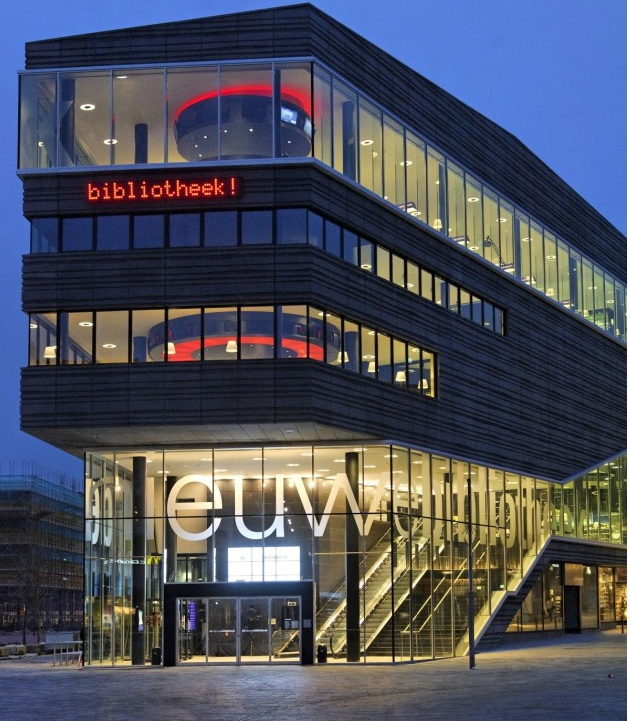If a library can totally reinvent itself there’s hope for us all!
Because sometimes it’s time to change and only readical change will do.
We wake up and discover that the world has shifted and we’re way behind the times. We learn, from our customers or our own self-reflection, that the story we’ve been sharing about ourselves is out-dated.
We need to re-invent ourselves.
I call this process re-storying. It’s about charting a future with a story that embraces change and keeps up with the times. I was thrilled this week to read an article by Cat Johnson on Shareable with a great example of a re-invention story focused on an old institution – a library in the Netherlands – that went from being dated and depressing to uber-hip.
I grew up a library-lover. But as I moved into my twenties and thirties, I pretty much forgot about community libraries. As an academic and book lover, I was into buying books. (And my “reading enjoyment” was obsessively centered around my dissertation.)
Until one day, I went with my husband Steve on a field trip to the new Seattle Central library. The outside of the building, with its dramatic glass front, announced, “this isn’t your grandma’s library.” Then the interior, with spiraling ramps connecting the stacks, took me on a dizzying ride.
I came out of the stacks dazed, weighted down with ten gorgeous oversize books about gardening.
“OMG, Steve, “ I said, “Do you think they’ll actually let me take all of these home?”
“Ah yeah,” he said, “After all, it is a library.”
Right. A library. Where you can take out books for free. I was thrilled!
I was back into libraries.
I noticed that while I’d been hibernating, there’d been some changes. The old story about libraries as nerdy, sleepy, low-tech, heavily controlled buildings that lived under the watchful eyes of librarians, was disappearing, and a new story about libraries as interactive community centers was being born.
The Nieue Bibliotheek (new library) in Almere, the Netherlands, is the best example I’ve read about of a library that completely re-storied itself.
About ten years ago, faced with disappointing and downward trends in visitors, the library staff and community in Almere decided to re-imagine what a library could be. They sent out survey exploring what users really wanted and began thinking outside of the box.
Instead of making small changes from within the system, they went for radical change. They drew lessons from retail merchandising and bookstores to envision a new kind of user experience.
If their old story was:
- Mostly about the circulation of books;
- Determined by what made sense to the librarians;
- About helping a user find a book;
- A place where people would drop in, pick up a book and leave.
- Threatened by the world of digital media.
Their new story was:
- About engaging community;
- Driven by user preferences and inspired by lessons from retailing;
- Focused on creating a dynamic, interactive user experience;
- Treating the library as a cultural hub;
- Embracing technology and digital media.
What they did was cool. Their survey uncovered that 80% of visitors didn’t know what they wanted to borrow in advance of a visit to the library.
So they have created a terrific browsing experience, modeled after that of a retail bookstore.
For example they:
- Group books into mini-shops according to life-style (youth, culture, health, travel, etc.) each space with its own ambience and theme. Big posters help users know the theme of the space. Books are presented frontally to encourage browsing.
- Use retail signage and merchandising to orient visitors;
- Train staff in marketing and customer service;
- Include a bustling news café – where hundreds of magazines and newspapers are provided and monitors by the circular bar display the daily news.
- Provide ongoing events and music programs;
- Offer a gaming facility and a reading garden;
- Invite customers to use a library based on-line personal profiling system – to make contact with others who shared their interest areas.
- And more!
Today attendance is booming with over a million visitors a year and the library is a thriving community hub. People visit regularly to connect, consult, study, and hangout.
If the old story about physical libraries saw them dwindling away with the rise of e-books, this new story is showing that a library can embrace the internet and still be a thriving physical hub in the community.
For me, the lessons from Almere go way beyond libraries. Listen to your customers. Think outside the box. Borrow models from other industries. Embrace how the world is changing. Be willing to risk.
If a beloved, but dated, institution like a community library can “re-story” itself for the future, imagine what possibilities exist for other institutions – and for ourselves!
Thanks to www.dailygood.org for introducing me to this article. Photos attributed to Wim Ruigrok











One Response
Libraries seem to grow and change as their towns grow and change. They are all wonderful in their own way – and they all respond as much as possible to the people they serve.–even the tiny ones that are only open a few hours a week.